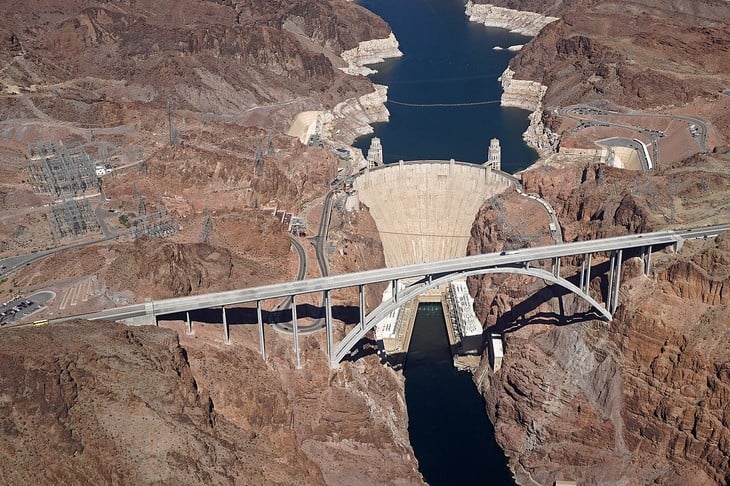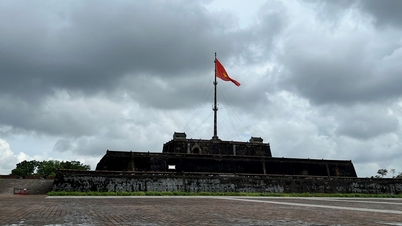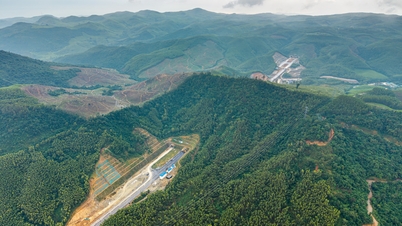
Hoover Dam and Mike O'Callaghan-Pat Tillman Memorial Bridge in the US - Photo: WIKIPEDIA
The Earth's pole shift can be traced back to two major waves of dam building around the world . The first major wave occurred in North America and Europe during the 19th and early 20th centuries. Then, the second major wave occurred across Asia and East Africa in the second half of the 20th century.
It all relates to the distribution of mass and the planet's moment of inertia. The Earth will spin like a ball on your fingertip. However, if the mass suddenly changes in one area, the rotation will begin to wobble.
Imagine placing a lump of clay on one side of a spinning ball. To conserve momentum, the side covered in clay will shift slightly outward, affecting the ball's rotation.
This is similar to how figure skaters spin faster when they bring their arms back: changing the weight distribution alters the rotational momentum.
In the case of Earth, the change in mass comes from water being held in giant dams. These man-made reservoirs redistribute the planet's mass, slightly shifting the positions of the poles, according to IFLScience on July 10.
In a new study, planetary scientists at Harvard University discovered the problem by looking at global data on 6,862 dams built around the world between 1835 and 2011. From there, the team calculated how much water the dams contained, how the water reshaped the Earth's mass distribution, and whether it was enough to shift the poles.
Overall, the team found that dam construction shifted the poles by approximately 113 cm and caused global sea levels to drop by 21 mm between 1835 and 2011. In the 20th century, this shift increased to 104 cm, but it did not occur in only one direction.
From 1835 to 1954, a wave of dam construction in North America and Europe caused the poles to shift toward the equator. During this period, the North Pole moved nearly 20.5 cm toward 103 degrees east meridian – the meridian that passes through Russia, Mongolia, China, and the Indochina Peninsula.
After 1954, the wave of dam construction shifted to East Africa and Asia. As a result, the pole began to shift in the opposite direction, deviating approximately 57 cm to 117 degrees west meridian – the meridian that runs through western North America and across the South Pacific .
"The fact that we're holding water in dams is not only drawing water from the ocean, which lowers global sea levels, but it's also redistributing the mass differently around the globe. We're not going into a new ice age because the poles are shifting by about a meter, but it's really affecting sea levels," said Natasha Valencic, lead author of the study and a PhD student at Harvard.
The shift of the poles is a cumulative consequence of the construction of thousands of dams around the world over decades. However, in some exceptional cases, a dam itself has its own impact.
For example, China’s Three Gorges Dam, the world’s largest hydroelectric dam, is so large that it could significantly affect the Earth’s rotation. According to NASA, China’s mega-dam can hold 40 cubic kilometers of water, enough to shift the Earth’s poles by about 2 centimeters.
The research is published in the journal Geophysical Research Letters .
Source: https://tuoitre.vn/cuc-trai-dat-dich-chuyen-vi-cac-dap-nuoc-tren-the-gioi-2025071113302913.htm


![[Photo] Prime Minister Pham Minh Chinh holds a phone call with the CEO of Russia's Rosatom Corporation.](/_next/image?url=https%3A%2F%2Fvphoto.vietnam.vn%2Fthumb%2F1200x675%2Fvietnam%2Fresource%2FIMAGE%2F2025%2F12%2F11%2F1765464552365_dsc-5295-jpg.webp&w=3840&q=75)
![[Photo] Closing Ceremony of the 10th Session of the 15th National Assembly](/_next/image?url=https%3A%2F%2Fvphoto.vietnam.vn%2Fthumb%2F1200x675%2Fvietnam%2Fresource%2FIMAGE%2F2025%2F12%2F11%2F1765448959967_image-1437-jpg.webp&w=3840&q=75)





















































![[OFFICIAL] MISA GROUP ANNOUNCES ITS PIONEERING BRAND POSITIONING IN BUILDING AGENTIC AI FOR BUSINESSES, HOUSEHOLDS, AND THE GOVERNMENT](https://vphoto.vietnam.vn/thumb/402x226/vietnam/resource/IMAGE/2025/12/11/1765444754256_agentic-ai_postfb-scaled.png)




















































Comment (0)